Vol 1 No. 13 TROPIC LIGHTNING NEWS May 27, 1966
Index
[The 1966 Vietnam issues of Tropic Lightning News were published in Saigon,
and are of lower quality than later years that were printed in Japan. Over
the years the photographs and text have faded and it has been difficult to
reproduce them. Even when the photos are unclear, I have been included
them to give a sense of the activities in the Division.]
“Tropic Lightning” struck in force 40 miles northwest of Saigon last week as
the 1st and 2nd Brigades began operation Wahiawa.
In the eighth day of the operation, the brigades were moving north and west
from Cu Chi. They have accounted for 143 VC killed so far on the
search-and-destroy mission.
One element of the division was helilifted into the Boi Loi woods, allegedly
the birthplace of the National Liberation Front.
The area was found to contain large quantities of VC material and equipment
although contact has been limited to isolated small groups of VC.
The first day of the operation saw the biggest capture of enemy medical
supplies made to date.
According to 2nd Bde. Surgeon Captain Gerald R. Herrin, the VC medical
supplies could last a battalion sized unit for at least a month.
“Most of the supplies were American, French, and a small amount of
Vietnamese. All of it was modern equipment.”
“This is the best quality of medical supplies that I have seen captured,”
Capt. Herrin said. “We’ve captured nearly as much as this before but we’ve
never gotten anything that compares with this in quality.”
“This definitely hurt the VC,” he said. “Just judging from what we’ve
captured before, we’ve got some very valuable things from them.”
Among the six large boxes of medical supplies were: 300 bolts of towel cloth,
80 syringes, 5,000 ampules of quinine, 1,400 strychnine ampules, 28,000
chloroquine tablets for malaria, 550 streptomycin ampules, 92 hepatrol
injectable ampules, 50 cod liver oil ampules, 72 campolan ampules, 30 dolosal
ampules, 400 bottles of penicillin and one dental kit, including a foot-driven
drill.
On the second day of the operation, another 500 pounds of medical supplies
were discovered by another division unit following a brief but fierce fire fight
with a VC unit securing the storage area.
Other division units have chalked up sizeable totals of captured enemy
supplies, as cache after cache was uncovered. As of 8 a.m. last Monday,
division units had confiscated 21 small arms of Russian, Chinese, and American
manufacture; 23,324 rounds of small arms ammunition; 4,000 lbs. of paraffin; 50
sheets of steel; 550 sheets of tin; 52 bicycles; and 704.1 tons of grain.
In addition, 138 structures had been destroyed as of Tuesday. Included in
the figure were a VC mess area, command post and training center and seven base
camps. Seventy-six tunnels, 12 bunkers, 13 trenches had been rendered unusable,
47 booby traps had been dismantled, and 13 VC sampans had been sunk.
In the base camps a complete munitions factory with equipment was discovered,
along with seven pedal-operated sewing machines and 36,000 yards of cloth.
Foodstuffs found, in addition to the large caches of rice, include 1,800 lbs. of
dried fish and 2,900 lbs. of peanuts. The current operation was named after the
Hawaii town of Wahiawa, located near the division, former Schofield Barracks
home. Many division families still live in Wahiawa.
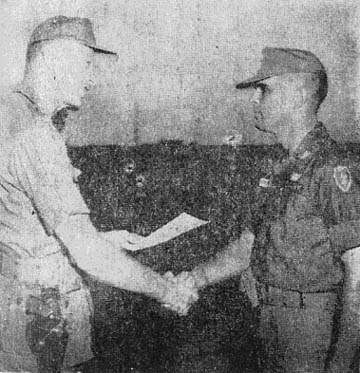 |
OUTSTANDING - Captain Dennis B. Bulger (r.), commander of Company A, 65th Engineer Battalion, receives a pleasant birthday present from Major General Fred C. Weyand, division commanding general - the U.S. Army, Pacific, Outstanding Leadership Award for the last half of 1965. Capt. Bulger, of Gouvernuer, N. Y.. is a graduate of Clarkson College of Technology, Potsdam, N.Y. He received a certificate and a silver plaque for his accomplishment. |
Cong Escape Attempt Fails in Boi Loi Woods
A wounded Viet Cong, trying desperately to hide from advancing Americans,
crawled to his death in the Boi Loi Woods during operation Wahiawa.
In a war where the enemy makes every effort to conceal his losses, the dying
VC made a vain attempt to escape the men of Company A, 1st Battalion (Mech), 5th
Infantry, but a long trail of blood gave him away.
Company A had surprised four Viet Cong on a trail in the southern section of
Boi Loi Woods during the search and destroy operation. They tried to escape.
Two or more were believed hit, and a trail of blood led to a tunnel where one
Viet Cong had crawled to die. Three M-1 rifles and a Russian carbine also were
found in the tunnel.
Further search of the area turned up the three others. All were dead . . .
all were so well disciplined that their last conscious efforts were to hide
their deaths from the enemy.
Two Commanders Decorated
Colonel Lynnwood M. Johnson, Jr., former 2nd Brigade commander, and
Lieutenant Colonel Robert G. Walker, formerly commanding officer of 1st
Battalion, 8th Artillery, have been awarded the Bronze Star Medal for heroism.
Both officers, who have returned to Hawaii, received the awards for combat
operations against the Viet Cong.
Col. Johnson was flying in his command and control helicopter on April 18,
observing action of 2nd Battalion, 27th infantry, when he noticed a number of
women and children fleeing from a village occupied by the communists.
Visualizing the best way to take the village, which was under attack by the
“Wolfhounds,” the colonel directed his pilot to set the aircraft down in the
forward area, which was less than 300 yards from the front line of attack.
Leaving the helicopter, Col. Johnson moved toward the line and called to the
2/27th operations officer, who warned the colonel that snipers were in the
hedgerows and he should stay low. Ignoring the warning, Col. Johnson directed
the operations officer to lift mortar and artillery immediately so the women and
children would not be harmed.
The colonel’s tactical plan, which was executed, saw the village taken
without further incident.
On Feb. 14, 1966, 1/8th Arty. was in direct support of 2nd Bde. Around 1
o’clock that afternoon, Company A, 1st Battalion (Mechanized), 5th infantry, on
a reconnaissance-in-force mission, came under intense Viet Cong fire..
When Col. Walker learned of the situation, he directed his helicopter to the
area. Flying at altitudes below 1,000 feet, placing the aircraft under heavy
ground fire, Col. Walker called artillery fire in to suppress the attacking V.C.
The colonel, noticing that the company appeared to be surrounded, directed a
ring of artillery fire to be placed around the 1/5th forces, forcing the enemy
to withdraw. In spite of the murderous Viet Cong ground fire, he remained in
the area and directed fire until all wounded personnel had been evacuated.
USARV Authorized To Give Direct Commissions
U.S. Army, Vietnam (USARV) now has the authority to appoint 2nd lieutenants
in the United States Army Reserve. Qualified applicants will go on duty as
commissioned officers once they have met all criteria.
USARV has received initial quotas in infantry, artillery, armor, engineer and
signal branches.
Processing of all applications will be through channels, where each
individual will be screened to make sure he meets all qualifications.
Applicants will be required to appear before an examining board.
Individuals receiving commissions through the program will remain in the
division as long as they can be reassigned to another, similar unit and still be
utilized in rank and MOS. According to USARV however, a letter from the
appointee’s commander should accompany the application if the commander wishes
to keep the appointee in his command. To qualify for the program, applicants must be on active duty as warrant officers or enlisted men in
grades E-5 through E-9 and be between 18 and 28 years old. The applicant almost
must have served on active duty with USARV at least six months when application
is made.
Battalion personnel officers have additional information concerning
requirements and making application.
25th Pledges Financial Aid To Orphanage
The 25th infantry Division is joining other American, Free World, and
Vietnamese forces and agencies in the largest combined civic action project
undertaken in Vietnam.
The program involves the establishment of a new and much needed orphanage
near Bien Hoa. Coordinating the project for the “Tropic Lightning” Division is
Lieutenant Colonel Robert R. Hicks, assistant chief of staff, G5.
The orphanage, under the sponsorship of the III Corps commander, Major
General Nguyen Bao Tri and Mrs. Tri will be initially constructed to care for
250-300 children. It will be designed to allow for future expansion to care for
as many as 1,000 children as additional funds become available.
Vietnamese, Free World and U.S. Forces within the III Corps area will conduct
fund raising drives beginning this month to raise sufficient money to complete
construction, purchase necessary equipment and allow continued operation. It is
estimated the cost will be about $100,000.
The orphanage will be known as the Dong Nai Orphanage and will be operated
solely through donors’ contributions.
| Major Nguyen Van Nha, flanked by Sergeant Major Robert W. Hawkins (l.), and Lieutenant Colonel Harley P. Mooney, Jr., 1/27th Infantry commander, being made honorary Wolfhound “colonel.” |
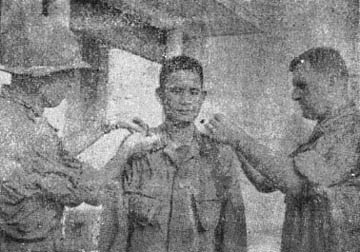 |
Page 2 TROPIC LIGHTNING NEWS May 27, 1966
Decorated
| ARMY COMMENDATION MEDAL | |
|
SFC Edward W. Benesch, HH and S Brty., 1/13th Arty MSgt. Walter C. Kolbo, 25th Admin. Co. |
Lt. Col. Claude D. Mangum, HHC and Band, Spt. Cmd. SFC Franklin C. Whitlock, Co. D, 25th Med. Bn. |
| AIR MEDAL |
|
|
SSgt. George A. Agnew, HH and S Btry., 1/8th Arty Capt. Gene E. Baxter, HH and S Btry., 1/8th Arty Maj. Norman S. Clark, 175th Avn. Co. Capt. Howard D. Deane, 175th Avn. Co. PFC Artuhr C. Ferries, 175th Avn. Co. 1st Lt. John S. Gleason, HH and S Btry., Div. Arty Maj. Robert F. Grandman, 175th Avn. Co. |
Lt. Col. Milton H. Hamilton, HHC, 2nd Bde. 2nd Lt. Charles L. Kendall, Co. A, 25th Avn. Bn. Maj. Leslie A. Layne, Co. A, 25th Avn. Bn. SSgt. Frank Y. Matsura, HHC, 2nd Bde. PFC John J. Monette, 175th Avn. Co. 1st Lt. Patrick F. Obeirne, HH and S Btry., 1/8th Arty Maj. William F. Winters, Co. A, 25th Avn. Bn. |
| PURPLE HEART |
|
|
Capt. Jimmy L. Adams, Co. B, 1/27th Inf. Sp4 Leroy D. Bishop, Co. B, 1/5th Mech. PFC Albert Bohannon, Btry. C, 7/11th Arty. Sp4 Daniel S. Davis, Co. B, 1/5th Mech. PFC Robert F. Dewey, Co. C, 4/23rd Inf. PFC Robert Donaca, Co. B, 1/5th Mech. Sgt. Robert S. Holmes, Co. B, 65th Engr. Bn. PFC James Hutchison, Co. C, 4/23rd Inf. PFC Sylvester Jones, Co. C, 4/23rd Inf. SSgt. Samuel P. Kaiuve, Co. B, 1/5th Mech. PFC Albert D. Lee, Co. A, 4/9th Inf. |
Sp4 Ronald L. Losey, Co. B, 1/5th Inf. PFC Ward W. Loskot, Co. B, 2/27th Inf. PFC Robert D. Mennen, Co. C, 4/23rd Inf Sp4 Robert C. Pietras, Co. B, 25th S and T Bn. Pvt William G. Roesch, Co A, 4/9th Inf. PFC James F. Steele, Co. C, 4/23rd Inf. 2nd Lt. Arthur Roth Jr., Co. A, 1/27th Inf. Pvt Arthur G. Stromstedt, HH and S Brty. 3/13th Arty. Sp4 Floyd Taylor, Co. A, 4/9th Inf. PFC Gene W. Toebe, Co. A, 4/9th Inf. |
KNOW YOUR ENEMY: A DEDICATED SOLDIER
What makes the Viet Cong and their way of warfare so significant is that they
started with so little in material assets, although they had a belief in a
well-proven doctrine (of subversion), a thorough knowledge of its tactics, and
the moral support of their fellow Communists throughout the world.
They had no industrial capacity. They had no substantial armed forces, only a
few thousand experienced guerrillas, and perhaps 100,000 supporters – mostly in
remote areas seldom visited by government representatives.
On the other hand, the Viet Cong had hidden stores of weapons and ammunition
left over from the war against the French. They had many trained and dedicated
Communists to provide leadership, and access to the resources of the Communist
regime in the North.
Finally, the Vietnamese Communists – North and South – were united in their
determination to use whatever means were necessary to bring the whole country
under Communist domination. Without massive U.S. and free world support, South
Vietnam might already have been added to the lost countries.
As in conventional wars, each side expanded its armed might after the war had
started. When it became obvious that the Republic of Vietnam in the South could
not be taken without military force, Hanoi began sending a growing stream of
infiltrators, arms and supplies into South Vietnam by land and sea. The
infiltrators were trained in the North, to assume key positions of leadership.
Communist China and other Communist countries. have supplied weapons and
ammunition, primarily through North Vietnam, the so-called Democratic Republic
of Vietnam.
The Republic of Vietnam Armed Forces (RVNAF), whose fight for freedom we
support, have increased their numbers and improved their equipment at a pace far
greater than have the Viet Cong. However, while the Front was experiencing its
greatest growth, 1963 and 1964, the free government of South Vietnam was
undergoing great political stress and frequent changes of administration.
These factors undoubtedly have facilitated the growth of the Front, but they
have not stunted the growth of the RVNAF, nor shaken their determination to
resist Communist aggression and preserve the freedom and independence of the
country.
The success of an unconventional army and a shadow government built up by
Communist direction, largely from the people and the resources of a state they
seek to destroy, is cause for concern. We must understand the reasons for this
and learn how to defeat such attacks, or they will be repeated again and again.
The Viet Cong fighting man is not “10 feet tall,” neither figuratively or
literally, being actually on the average only five feet three inches in height.
Nor is he an incredible fanatic - many thousands of Viet Cong desert or go over
to the side of the government every year. His effectiveness cannot be
attributed entirely to the outside support he receives the RVNAF have received
far more assistance from abroad.
Yet the Viet Cong has developed into a kind of fighting man who is capable of
waging an unconventional war under conditions that would seem hopeless to the
average orthodox soldier.
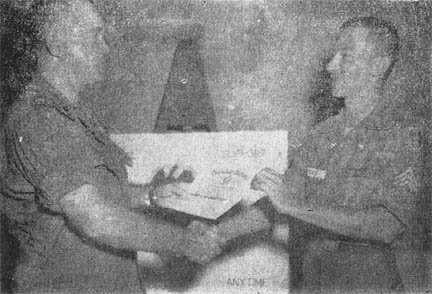 |
SWORN IN - Master Sergeant Roy J. Henry, assistant chief supply sergeant for the 25th Infantry Division, reenlisted recently for the sixth time. Sgt. Henry, who joined the Army in 1948, reenlisted in ceremonies conducted by Lieutenant Colonel William Davis, division G-4. |
June Weather Predictions
During June, all of southeast Asia is under the influence of the southwest
monsoon. The weather will usually follow a daily pattern, highlighted by
thundershowers in the afternoon and early evening.
Rain can be expected on about 22 days of the month with a total average of
12.5 inches. Heavy showers will not normally last more than 45 minutes.
Cloudiness will prevail most of the day, with only about one-quarter of the
day in sunshine. But temperatures will not be affected much; the mean daily
maximum should be 92 with an average minimum of 75.
Although the temperatures are lower for June than May, the high relative
humidity will make it seem just as warm. The average relative humidity for the
whole month will be between 80 and 90 percent.
June is also the advent of the typhoon season. Luckily, these fierce
tropical storms do not normally move inland in this area of the world.
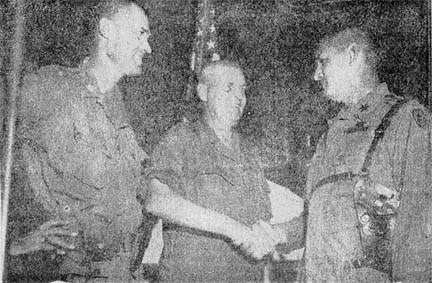 |
AGAIN - Sergeant Major Robert B. Miller, 1st Battalion, 8th Artillery, became the first sergeant major to reenlist since the division's arrival in Vietnam. this enlistment, when completed, will bring SMaj. Miller's total service in the Army to 24 years. SMaj. Miller, of Killeen, Tex., prior to joining the division in August 1963, served with 3rd Battalion, 13th Artillery, 1st Armored Division, at Ft. Hood, Tex. Colonel Daniel B. Williams, Division Artillery commander (r.) administered the oath of enlistment while Major Frank E. Deam, commander of 1/8th Arty., looked on. (Photo by Nelson) |
| The TROPIC LIGHTNING NEWS is an
authorized publication of the 25th Infantry Division. It is published
weekly for all division units in the Republic of Vietnam by the
Information Office, 25th Infantry Division, APO U.S. Forces 96225. Army
News Features, Army Photo Features and Armed Forces Press Service material
are used. Views and opinions expressed are not necessarily those of the
Department of the Army. Printed in Saigon, Vietnam, by Dai Doan Ket
Publishing Company. Maj. Gen. Fred C. Weyand . . . . Commanding General Maj. William C. Shepard . . . . . . Information Officer 2nd Lt. Patrick J. McKeand . . . Officer-in-Charge Sp5 Dale P. Kemery . . . . . . . . . Editor PFC David A. Pierce . . . . . . . . Editorial Assistant |
Page 3 TROPIC LIGHTNING NEWS May 27, 1966
25th Inf. Div.: From Hawaii to South Vietnam
The “Tropic Lightning” division has been in a state of flux since early in
December when the order for deployment was given. Since that time the division
has undergone a complete change, a change which took a strong, well-trained
unit, broke it into several parts, then rebuilt it in a new location and a new
situation.
First to move was the 3rd Brigade Task Force. In conjunction with the Air
Force, the Broncos participated in the largest, longest, and fastest (for number
of troops involved) airlift on record. Operation Bluelight saw the 4,000-man
task force carried from Hawaii to Pleiku, Vietnam, in less than a month.
When the last arrivals landed in the highlands they found a tent frame city
well on its way to completion. A perimeter had been thrown up and operations
against the Viet Cong had already begun.
In mid-January, the first brigade-sized operation, dubbed Taylor, began.
This was followed in rapid succession by Garfield, Lincoln, Longfellow, and the
current operation Paul Revere.
Major General Stanley R. Larsen, commanding general, I Field Force, Vietnam,
summed up the performance of the 3rd of the 25th last week while talking to
Brigadier General Glenn D. Walker, task force commander. Said General Larsen,
“You haven’t begun . . . you’ve arrived!”
Not long after 3rd Bde. began its deployment by air, the 2nd Brigade Task
Force set out by sea. The final destination, Cu Chi, was reached on January
25. Cu Chi and the area around it were considered Viet Cong property prior to
the brigade’s arrival.
Not so fortunate as the Broncos, who met light initial resistance moving into
Pleiku, 2nd Bde. had to fight for every square foot of land needed for the base
camp. Fight it did and as it fought, it built. The base expanded from a tight
ring, where VC snipers were apt to pop up anywhere, to an 800,000 square yard
city as secure as any area in V-N.
Operations Honolulu, Circle Pines, Kahuku, Kahala, Del Ray, Kolchak I, and
many more stand as monuments to 2nd Bde. tenacity.
While the brigade was conducting those operations, the Cu Chi base spread out
with the arrival of Division Troops, division headquarters, and Support
Command. Most recently, the 1st Brigade Task Force arrived, quickly getting its
feet on the ground and now the first combined 1st and 2nd Brigade operation,
Wahiawa, has begun.
Nostalgia
Waiting in V-N’s Quiet Hours
A warm, lazy breeze slides across the land, bending swamp reeds and gently
bowing the tent’s canvas sides. A clear sky fills quickly with a thousand eyes
while below tiny land creatures harmonize their faint vocal croaks.
Blessed with an evening of tranquility, the men of Company B, 1st Battalion
(Mechanized), 5th Infantry, settle back for another evening in the field.
A soft moon hangs over the camp and reflects its gentle beam. Using the
light, some of the men unfold and re-read old letters from home while others
thumb through worn and frayed pages of their pocket Bibles.
Throughout the camp, men group and speak in soft whispers. Some speak of the
war, which tonight, seems so far away. Others dream of future plans, but mostly
they talk of home.
Faint smiles play on their lips as their reminiscing goes farther back. They
sip hot coffee and talk of the past and how good it will be to get back. And as
the night grows older, they talk about the wife and kids and occasionally pass
wallet-bent photographs.
A faint blast occasionally sounds in the background. Hands tighten on
M-16s. A brief silence. And then nothing. The grips loosen and the
conversation flows back to home, back when, to them, the war was only in the
newspapers.
Gradually the coffee cups grow empty and the groups begin to break up. The
men roll out their sleeping gear and settle for the night. Tomorrow, possibly
tonight, they will again be part of the war. But now, while they fall into
sleep with their still warm thoughts, they’re back home . . . back with the
girl, the car, the hamburger stand - or the wife and kids.
TOC Keeps Wahiawa Combat Pulse Beating
The nerve center of operation Wahiawa is the forward tactical operations
center (TOC) based for this mission northwest of Cu Chi. It is here, amid the
buzzing of field telephones and bustling activity, that all status reports of
various units are collected and evaluated.
Major Thomas Ulvenes of Faribault, Minn., 2nd Brigade operations officer,
conducts his daily business from the TOC. One of his main responsibilities is
keeping the operations log, a running account of anything of importance that
takes place on the operation.
If helicopters are needed by ground units, Maj. Ulvenes, or one of his
assistants, will coordinate with the aviation officer to direct them to where
they are needed. It a man is injured, he calls in the “dustoff.”
Maj. Ulvenes also is responsible for coordinating operations with helicopters
assisting the division in resupply and tactical maneuvers. His section
maintains the operation Wahiawa command map, on which positions of the various
units and operational statistics are posted.
The hum of activity in the TOC is characterized by reliance on
communications, upon which modern fighting units depend. The TOC never sleeps,
maintaining an around-the-clock watch.
Maj. Ulvenes, along with the other officers and men, keeps his finger on the
pulse of an operation, which to him becomes a living, breathing thing. He is
part of a team geared to smash the Viet Cong area in Vietnam.
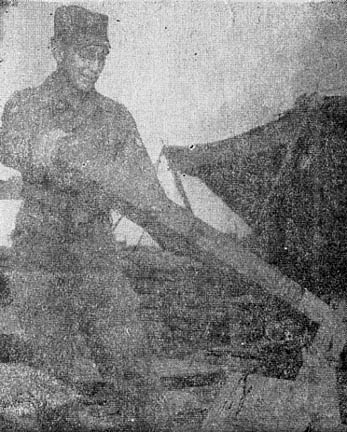 |
CRUNCH! - Sp4 Frankie D. Burnham demonstrates his invention, the “Gazop”, an empty can crusher. (Photo by Nelson) |
3/4 Cavalry “Gazop” Crunches Cans in Beautification Program
“Necessity is the mother of invention,” so they say. When it became
necessary to flatten all empty beer and coda cans in the division base camp,
enter the inventor, Specialist Four Frankie D. Burnham, Troop B, 3rd Squadron,
4th Cavalry.
Sp4 Burnham, of Vinemont, Ala., saw the need for a device to crush the
numerous empty cans. Using the principle of leverage, he built what the men at
3/4 Cav. call the “Gazop.”
The Gazop consists simply of a 4 x 4 beam partially buried in the ground with
another plank hinged to its top. The operator, or “Gazoper,” simply inserts an
empty can in the angle formed by the two planks and applies a little pressure.
Gazop! The can is flattened like a pancake. Can gazoping, a new division
skill, means more discarded cans can be removed in the same amount of space.
Too, there is something satisfying about pulling the lever and seeing a can
flatten with a delicious crunch – er – gazop!
FLASH SHOWS TELLTALE CONG SHENANIGANS
Lightning struck once near a squad from Company C, 1st Battalion (Mech), 5th
Infantry, on a recent operation northwest of Cu Chi. That once was enough.
The squad, led by Staff Sergeant Cleophus Gibson, Milwaukee, Wis., moved into
a pre-dusk ambush site, set up Claymore mines and waited for the Viet Cong.
“It was just starting to get dark when a big rain came up,” Sgt. Gibson said.
“And we could see hardly anything.”
“Lightning flashed over the sky, and we saw four VC, one of them bent over
the Claymore.”
The mines were detonated and two VC were killed by body count and two others
were either wounded or killed, then carried off.
“If it hadn’t been for the lightning, they may have been able to turn those
mines toward us,” the sergeant said.
1ST BRIGADE LEARNS HOW IT IS
It was the first day of the first large scale operation for 1st Brigade.
They had been in Vietnam for less than two weeks with most of their time spent
getting settled at the “Tropic Lightning” base camp. As operation Wahiawa
began, they learned what they would have to live with for the next twelve
months.
The day began with a hasty breakfast, then assembly and departure. At first
the heavy packs dug into their backs. By the time they had stepped off their
first few miles the load had adjusted. Now their enemy was the rising heat.
Drops of sweat slipped from under their helmets and itched until they were
absorbed by already soaked fatigues. As they cut their way through the dense
brush in a search for Viet Cong tunnels, a new itch began. Large red ants
dropped down from the overhanging brush. With a savage bite they clung to
exposed arms and necks.
Late afternoon brought a quick, but driving, rain. At first it was
refreshing but as it soaked into their packs and clothing the weight on their
backs seemed to double.
The ground they would sleep on became slimy and held each step to the
ground. The stench of decay permeated the air, and with the smell and rain came
mosquitoes and crawling insects. The first day did not introduce them to their
enemy, but it did show what they would have to endure daily in their search for
him.
Page 4 TROPIC LIGHTNING NEWS May 27, 1966
A PUSH
 |
THE PLAN |
| THE SEARCH |
 |
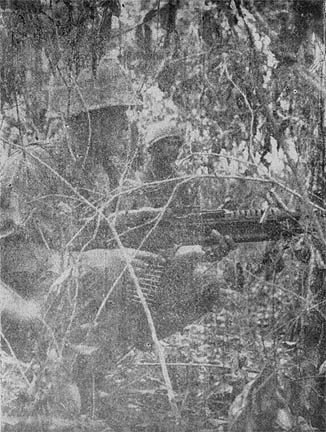 |
THE WAIT |
| THE MOP-UP |
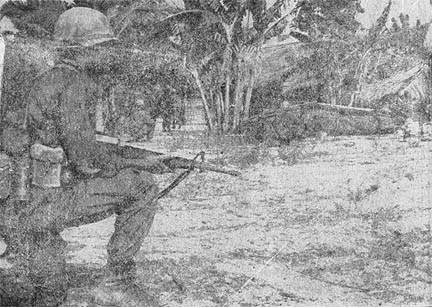 |
Page 6 TROPIC LIGHTNING NEWS May 27, 1966
Fire Team Chiefs Schooled on Mines
“It’s a matter of learn or die,” said Master Sergeant Jerome Paley of New
York City, to a class of squad leaders and fire team chiefs from 2nd Brigade.
Sgt. Paley’s blunt statement began the first of eight, two-hour classes on
Viet Cong mines and boobytraps. With the assistance of the 65th Engineer
Battalion intelligence officer, Lieutenant Arnold E. Cheal, of Lansing, Mich.,
Sgt. Paley explained the operation of 20 enemy devices, using illustrations to
detail their construction.
“One of our biggest problems is that VC mines are easily installed. They
come in, plant it and get out,” said the instructor.
“Each type of mine must be handled differently,” he continued. “Before
blowing a mine you’ve come across, check to see what type it is. There’s no
sense using up explosives on something that can be safely removed. Remember,”
cautioned Sergeant Paley, “you can carry only so much explosive.”
The Viet Cong, he told the group, can and do make mines and bombs from nearly
anything. “As late as February of last year we were still finding boobytraps
made of French 105 and 155mm shells.”
The class will be given to the men of each of the line battalions, as well as
the support units.
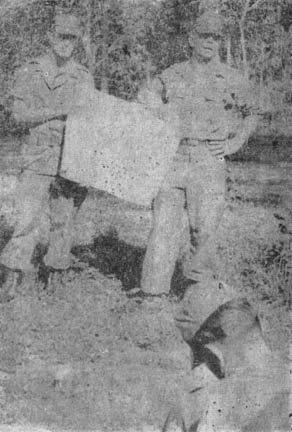 |
WARNING – MSgt. Jerome Paley, New York City (right), discusses the various types of boobytraps, mines and bombs in the Viet Cong arsenal with squad and fire team leaders from the 1st and 2nd Battalions, 27th Infantry. Assisting Sgt. Paley is 1Lt. Arnold E. Cheal, 65th Engr. Bn. G-2. (Photo by Hanson) |
Treatment Turns Search-and-Destroy
What started out as a routine civic action mission turned out to be a “search
and destroy” operation at the same time..
During operation Paul Revere, presently being conducted by the 3rd Brigade
Task Force southwest of Pleiku, a squad from Company A, 2nd Battalion, 35th
Infantry, escorted a civic action group from the 41st Civil Affairs Team
attached to the brigade, on a mission to the village of Piei Ea La.
When the small task force arrived at the village, located about two miles
from the brigade’s forward command post at Than Han, the squad made sure that it
was safe to enter.
The civil affairs team, headed by Capt. M. D. Sparago, the 41st’s medical
officer, entered the relatively small village to conduct a sick call.
Capt. Sparago was assisted by Second Lieutenant Hugh Harris, a member of the
2/35th’s medical team, and a medic from Army of the Republic of Vietnam. He
treated all of the ill villagers who appeared.
The three medical specialists also handed out vitamins and candy to the small
children in the village.
While they were there, the civic action team also explained the reason for
the American’s presence in their area and that the 3rd Bde. intended to operate
in the vicinity of the village of Plei Ea La.
They also told the people that, should they become sick, they could get a
free pass to go to the Pleiku Hospital for treatment.
After spending nearly two hours in the village the small task force headed
back to the brigade forward command post by a different route.
About mid-way on their return, the men of the patrol spotted a sprung
booby-trap. Carefully by-passing that spot near the trail, they came upon a
lone grain-storage hut.
It was found to be a Viet Cong rice cache of nearly one ton.
By the time the little force returned to the command post they had
accomplished two missions: making friends with the villagers of Plei Ea La and
disrupting the Viet Cong’s future menu.
Villagers Get First Health Aid
Six Montagnard villages and over 400 villagers of the Le Thanh district are
receiving health and sanitation aid as part of the 3rd Brigade Task Force
operation Paul Revere southwest of Pleiku.
Members of the “Bronco” brigade’s civic affairs teams, presently working to
improve the villagers’ standard of living in the areas of operation, are helping
the Vietnamese health and sanitation teams located within the district.
The brigade doctors are treating hundreds of villagers for such diseases as
skin infections, malaria, and a few cases of tuberculosis. Items such as soap,
food, medicine, and clothes are being distributed to the villages. And the
doctors are working to refine the medical skills of the Vietnamese medics
stationed within the district.
Members of the brigade are working closely with teams of Vietnamese in trying
to wean the people away from the Viet Cong. Loudspeaker appeals, movies and
pamphlets are used in an effort to rebuild confidence in the national
government.
With 4/23rd Inf.
Sense of Humor Remains In Spite of VC Bullets
War is always serious business, managed and fought by serious men. On
occasion, even in the heat of battle, humor breaks through this wall of
seriousness.
During the first few days Operation Wahiawa, the men of 4th Battalion, 23rd
Infantry, met little Viet Cong resistance. On the morning of the fourth day,
Company C ran into four, well-hidden VC snipers. The first platoon returned
fire, but the third platoon, following the first, was unable to fire for fear of
hitting their own men.
When the shooting started, the third platoon had been walking through a
graveyard. Immediately, they dropped behind the mounds as enemy shells tore at
the ground close by.
It was a serious moment. For most of them it was the first they had been on
since they arrived in Vietnam three weeks ago.
Over the sound of the incoming bullets could be heard voices that were
slightly less than frantic.
“Hey, Sarge. you OK?”
“Yeah, but this grave is too short. Ya wanna trade?”
“OK, push it over here.”
Another broke in, “Hey, doc, if I get hit, you hurry on over here.”
“Sorry, pal, I don’t make house calls.”
“I’m hungry”
“I’ll buy you a hot dog in the next village,” a young private offered
bravely.
The first laughed back, “When’s your voice gonna change, you skinny POW?”
The banter went on until the firing ended. They got up slowly and carefully,
shook off the ants and the dust and resumed their search.
13TH ARTILLERY GIVES BARBECUE TO VIET CONG
Six rounds of 155mm ammunition make an impressive sight stacked next to a
howitzer. As 583 pounds of exploding steel, those six rounds are even more
impressive . . . especially for a Viet Cong who has the shells raining down
around him.
That was the situation near the Army of the Republic of Vietnam (ARVN) camp
at Trang Lam, about two miles northwest of Cu Chi.
At 11:25 p.m, May 18th, a U.S. advisor to the ARVN camp placed an urgent call
to the division’s Fire Support Element. The caller said the VC were attacking
the compound in force and requested artillery support.
Immediately, the message was relayed to the Division Artillery Fire Direction
Center. From there, the mission was assigned to 3rd Battalion, 13th Artillery,
who in turn assigned it to Battery B. Necessary data were determined for the
guns, and two 155mm howitzers roared into action.
To say simply that “six rounds of 155-mm howitzer fire exploded” hardly
describes the sensation of having the world erupt.
Within 13 minutes of the initial fire request, the would-be attacking VC were
routed.
| GOING UP – Lieutenant Colonel Aron E. Walker (r.), commanding officer, 3rd Battalion, 13th Artillery, congratulates Sergeant First Class Ernest Little, the battalion motor sergeant, on his promotion to his present grade. (Photo by Alvaranza) |
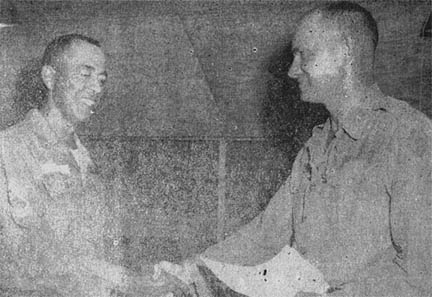 |
Page 7 TROPIC LIGHTNING NEWS May 27, 1966
57th Med. Det. Pulls Double Dustoff
When a helicopter flies into a combat zone to evacuate wounded, it is called
a “dust-off.” When a helicopter flies into a combat zone to evacuate a
helicopter that was sent to evacuate wounded, that’s called “something else.”
First Lieutenants Thomas Milner and Robert Langsdorf were waiting in their
UH-1D “Huey” helicopter at the 2nd Brigade forward command post. It had been a
moderately busy day for the chopper crew. They were attached to the 2nd Bde.
from the 57th Medical Detachment as a dustoff team during operation Wahiawa.
A call came in from a unit of the 1st Battalion, 27th Infantry, to evacuate
two wounded soldiers. Milner and Langsdorf took off for the appointed landing
zone accompanied by two gunships, but after a short while the protecting
helicopters an low on fuel and had to turn back. By the time the dustoff ship
reached its destination, there were four wounded to pick up. The medics were as
gentle as possible assisting the men into their litters aboard the chopper but
light rain had made the deck slippery. It took longer than usual to get the men
settled but they were on their way in a few minutes.
Apparently it had been too long. As the chopper slowly lifted its heavy load
and headed out, automatic weapons opened up. They made a run for it, but from
500 meters out a slug cut through the transmission. Then another hit punctured
the hydraulic system and oil started leaking badly.
As pilot Milner nursed the ship around and headed back to the landing zone,
Specialist 4 Mike Avers, crew chief, cut loose with his M60 machine gun and
co-pilot Langsdorf saw a Viet Cong sniper fall from a tree. Two more VC rushed
out and quickly dragged the body away.
The wounded ship limped back to the landing zone but could go no farther. It
had suffered 15 hits and would not fly again without major repairs. As soon as
the Huey had landed, the infantry threw up a security net but by then the VC had
located the ship and sniper fire became heavy.
“It was just like an old western,” said Lt. Langsdorf. “There we were in our
circle, surrounded by the enemy. Then, just when things started looking
blackest, John Wayne came charging in with half a dozen boys in blue and saved
the day.”
Actually it was a unit of the 3rd Squadron, 4th Cavalry, that came charging
in to save the day. Five armored personnel carriers operating in the area had
heard the pilot’s radio message. They rushed to the area and set up defensive
positions spraying the jungle with their 50 caliber machine guns.
Things quieted down in a short time and another helicopter was called in to
evacuate the wounded men who, by then, numbered six. The problem was how to
evacuate the wounded helicopter? Lt. Milner decided the only way to get
anything out of there was the same way he had come in - by helicopter.
He called division headquarters and asked for a CH-47 “Chinook,” a huge,
double rotor helicopter that can carry 30 men and a 105rnm howitzer with ease.
Twenty minutes later the giant Chinook, with a sling hung from its belly, was
hovering over the downed Huey. The sling was quickly attached and, with a groan
and a jerk, the big ship lifted its much smaller cousin into the air.
Back on the ground, Lt. Milner watched his ship fly off without him and
commented, “I wonder what we’d have done if they’d shot down the Chinook. Can’t
you see a dustoff for the dustoff that came to dustoff the dustoff that got shot
down during a dustoff?”
May I Have Your Number, Please?
It is said that “A general without communications is just a general, but a
general with communications is a commanding general.”
This certainly is true at 3rd Brigade, where Signal Officer Major Morris P.
Gray is the man who must see that the commanding general has the
communications. It is his job to make sure that brigade forward command post
(CP) communications are set up as quickly as possible to allow the brigade
commander and staff to be abreast of combat action during operations such as the
current Paul Revere.
With the brigade Headquarters Company communications platoon and a platoon
from Company B, 125th Signal Battalion, Maj. Gray gets the task done.
The signal battalion element consisting of 50 men under Sergeant First Class
Alfred E. Taylor, of Sierra Vista, Ariz., provides the VHF (Very High Frequency)
radios for transmission of 12 circuits back to the main switchboard at the
Pleiku base camp, some 30 miles from the forward CP. Another radio “rig”
provides the VHF (Very High Frequency) radios for transmission of 12 circuits
back to the main switchboard at the Pleiku base camp, some 30 miles away from
the forward CP. Another radio “rig” provides seven channels to the 6th
Battalion, located at Plei Me, which supports the task force.
Within two hours after the signal unit arrived at the CP location, they had
erected two 45-foot antennas, and the first “subscriber” could talk to anyone by
phone, almost anywhere in the world – provided the lines were not busy.
While all the arduous work of installing the large antennas and laying heavy
communications cable throughout the area is being done by the signal people, the
brigade commo platoon has its own work to do.
Wiremen, such as Specialist Four James E. Van Hoose of Picker, Okla., and PFC
David C. Gusti, of Griswald, Iowa, string out more than 25 miles of commo wire.
They don’t just drop it on the ground either. Frequently, they are required to
climb trees to string the wire, other times they have to dig trenches to bury
it.
The wire, 25 miles, is connected to about 50 telephones within the brigade
headquarters area.
Sergeant George Kukawa of Haiku, Maui, Hawaii, is the operation’s wire
foreman. It is his job to check the wire to see that it is laid properly and
connect the ends of the wire to the switchboard van.
“The first telephone was installed within 20 minutes,” Sgt. Kukawa said.
When asked how many phone calls his switchboard operators handle during the
day, Maj. Gray replied, “During operation Longfellow we took an average hour and
counted the calls into the switchboard. We handled 30. This is not during the
peak time either.
“Calls slack off about 10:00 at night until around 6:00 in the morning. We
usually handle about 15 calls an hour during this slack time,” the major stated.
Once the phones are installed and the system is in working order they can
hardly relax. Wiremen are constantly out checking the wire to see if it has
been cut or broken. If they find a break, they fix it as they continue to check
the seemingly endless miles of commo wire.
When subscribers complain that their telephones are not working properly the
commo platoon is called and a man is sent to repair the phone.
Switchboard operators must remain alert on the boards to handle calls at all
hours of the night and day to keep the communications pulse of the brigade
throbbing around the clock.
Brand New Post Office Built in Only One Day
In the early morning hours last Saturday, a new landmark appeared in the
division’s base camp. The building, a new Army Post Office (APO), had been
non-existent just 24 hours earlier.
The day before, materials arrived for two, 16x32-foot, general purpose tent
kits, with instructions to erect a building as soon as possible.
Working through the night, the work was all but completed, the “instant APO”
including a street-metal roof. The new building will double the present
facilities for sending, receiving and distributing the mail to the division.
The division postal officer, Captain Lawrence M. Osaki, explained that, in
their old facilities, “If over five men were sorting the mail, they were just in
each other’s way.
Now, with an added 1,017 square feet of working space, the APO will be able
to handle the 5,000 lbs of mail received daily efficiently.
Capt. Osaki said the APO will continue to use present facilities along with
the new structure. He said he foresees a possible average increase of 1,000 lbs
of mail a day.
 |
Sgt. George Kukawa of HHC, 3rd Bde., connects one of the many telephone lines that are in use during operation Paul Revere. (Photo by Sutphin) |
Charlie’s Gone
Where is Charlie? Just left!
Such has been the experience of r members of 1st Battalion, 14th Infantry,
and 2nd Battalion, 35th Infantry, who were maneuvering on operation “Paul
Revere” last week southwest of Pleiku.
The battalions have uncovered much evidence that the Viet Cong had been
present, but just left. On separate sweeps during the first week of operations
communication cables were located. Over sixty abandoned huts have been found,
some of which had water boiling within. Large areas of punji stakes and
numerous large caves also were uncovered.
The only direct encounter with the Viet Cong was made on May 12 by 1/14th
troops who made contact with a Viet Cong rifle squad. The VC broke contact
leaving behind four dead. There were no friendly casualties.
Cav. Aero Platoon Goes In First
The 3rd Squadron of the 4th Cavalry’s Aero Rifle Platoon is a unique part of
the Army’s effort to repel the Viet Cong in division operations.
Commanded by 2nd Lieutenant John F. Alto, of Seaside, Ore., the unit has been
operating as part of the 3/4 Cav’s “D” Troop since their arrival at Cu Chi on
March 31.
The platoon is composed of 42 men in four squads. They perform their
airborne functions in five UH-1D “Huey” helicopters.
Their task is to perform a variety of reconnaissance, observation and gunship
duties. The men are specialists in bringing rapid aid to U.S. units under
attack. Two squads of the platoon are always “on call.” If needed, the men can
be briefed and in the air in 15 minutes to assist the unit under enemy fire.
Lt. Alto explained that the Aero Rifle Platoon is sometimes called on to do
observation work for a motor convoy watching for any sign of Viet Cong attack.
If enemy fire is evident, the men can be sped to the scene of action and
deployed on the ground to protect the convoy. The new unit’s capabilities go
well with the division’s motto. “Ready to strike, anywhere, anytime.”
Page 8 TROPIC LIGHTNING NEWS May 27, 1966
| Vietnam Communique... A weekly summary of major Army actions in the Republic of Vietnam compiled by Army News Features from Department of Defense and published Official MACV Communiques. May 12 through May 18, 1966 1st Cavalry Division (Airmobile). – Operation DAVY CROCKETT, which began on May 4 about 50 miles north of Qui Nhon in the Bong Son area, continued with only light contact with the enemy reported. In another action, a unit killed 28 Viet Cong during a fight on May 16 with an estimated Viet Cong battalion. The engagement took place about 35 miles northwest of Qui Nhon. The VC were reported to be dug-in and well camouflaged. Friendly casualties were reported as moderate. 1st Infantry Division. - Units terminated Operation BIRMINGHAM on May 17. The enemy casualty toll for the operation, which began on April 24 about 55 miles northwest of Saigon, totaled 116 killed, 28 captured, 28 suspects detained and 228 individual weapons seized. The infantrymen also reported seizing large amounts of enemy materiel, equipment, supplies and facilities. Friendly casualties were light. 1st Brigade, 101st Airborne Division - A unit reported locating an abandoned 50-bed enemy hospital on May 13 while continuing search and destroy operations in AUSTIN VI about 95 miles northeast of Saigon. As of May 14, the paratroopers had killed 89 Viet Cong, captured four, seized 31 individual weapons and six crew-served weapons since the operation began on May 1. Friendly casualties remained light. 173rd Airborne Brigade (Separate) – No major actions reported. |
65th Provides “Instant Waters”
Almost before the first foxhole was completed at the 2nd Brigade’s forward
command post during operation Wahiawa, engineers were working on ways to wash
the first day’s sweat into the ground.
Company B, 65th Engineer Battalion, found the solution. Sweeping in a broom
like motion across the open field inside the base perimeter, a bulldozer dug the
12-foot well in less than two hours. When it hit water, six or seven men went
into the hole and put on the finishing touches.
The engineers drained a little of the muddy water, testing the sides to see
if they would hold up under pressure. After digging down a few more feet, water
was ready to be pumped.
The new water hole has two electric pumps - one to bring out the raw water
and the other to distribute it. More than 1,500 gallons will be taken out each
hour for washing and drinking.
The water requires the minimal treatment - chlorine and filtering - to be
made potable.
| EXCAVATION – On the recent operation Maili near Bao Trai, an Army bulldozer digs out positions for mortar and command post emplacements for the 1st Battalion, 27th Infantry. This dozer is part of Company B of the 65th Engineer’s arsenal of construction and earth-moving equipment. (Photo by Carollo) |
 |
Viet Cong Lose Rice By Hundreds of Tons
The Viet Cong in Hau Nghia Province will have a little less rice in their
bowls in coming months as the men of 1st and 2nd Brigades continue to discover
tons of hidden VC rice on operation Wahiawa.
To date, more than 800 tons of rice have been found. Most of the rice is
being recovered and distributed in the division’s area to friendly Vietnamese.
The 1st Bde, has given several tons of rice to dependents of the 49th
Regiment, 25th Division (ARVN). The rice was part of a 30-ton Viet Cong cache
found last week by the 2nd Battalion, 14th Infantry.
According to Major Ray J. Groves, civil affairs officer for 1st Bde., after
capture the rice was inspected and processed at the MY HOA rice mill and
distributed to the dependents.
In a short speech before the distribution of the rice, Mai. Grove said the
visit was the “first of many planned visits to distribute rice and other
items.” He also said the 1st Bde. Has become the unofficial sponsor of the 49th
Regiment’s dependents.
The rice was distributed in 30-pound bags to the families of the regiment’s
lower ranking men. The bags went first to the survivors of men killed in
action, then to other families. Those with the most dependents received
priority.
The rice was processed at no cost to the United States. The mill agreed to
process 50 bags and keep two as payment.
Other items on Maj. Grove’s list of proposed projects to aid the brigade’s
‘adopted family’ include providing pumps for their wells and digging sanitary
drainage ditches.
Ambush Nails Filching Cong
An ambush sprung by Company A, 4th Battalion, 23rd Infantry, accounted for
seven Viet Cong killed as the fifth day of operation Wahiawa ended.
Co. A, along with the rest of the battalion, spent the fifth day of Wahiawa
in a clearing near the Ho Bo woods. At dusk, the battalion gathered their gear
and moved to a new location about two thousand yards away.
As the battalion moved out, Co. A slipped into the tree line to ambush any
Viet Cong force that might try to salvage any U.S. equipment left behind. Their
break from the battalion was accomplished with such stealth that few others in
the battalion realized their absence.
A Co. didn’t have to wait long for their plan to bear fruit. A squad of Viet
Cong came within an hour and a brief, but fierce, fire fight resulted in seven
VC killed.
Other accomplishments in the search and destroy operation thus far include
the capture of five VC weapons with over four thousand rounds of ammunition,
four Chinese Claymore mines, 50 booby traps, along with salt, grain, peanuts, 36
hand grenades and many VC documents including a VC squad leader’s activity
book. They also destroyed numerous tunnels and 20 VC huts.
Wolfhounds Raid Village Used For VC Training
Company C, 2nd Battalion, 27th Infantry, launched operation Wahiawa by
uncovering a complex Viet Cong training village which revealed a modern
classroom containing pictures of Joseph Stalin, Ho Chi Minh and Mao Tse Tung.
The village was apparently hastily evacuated as elements of the first and
second platoons swept right of the complex and the third platoon moved directly
into it under enemy sniper fire. The lone sniper, under heavy fire from the
Wolfhounds, dropped his Chinese .30 caliber sub-machine gun and fled.
Staff Sergeant Floro Rivera, of Wahiawa, Hawaii, acting platoon leader of the
third platoon, said the heavily camouflaged, permanent installation was built to
house and train a VC company.
The floors of the buildings were about four feet below ground level, and
thatched roofs stood about four feet above the ground. The top and sides were
camouflaged with jungle vines and trees.
Thanks to:
The 25th Infantry Division Museum for providing the volume of 1966 Tropic
Lightning News,
Ron Leonard, 25th Aviation Battalion for finding and mailing them,
Kirk Ramsey, 2nd Bn., 14th Inf. for creating this page.
This page last modified 09-14-2006
©2006 25th Infantry Division Association. All rights reserved.